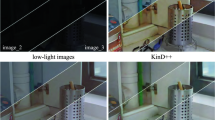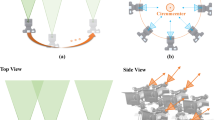Abstract
Modern developments in image technology enabled easy access to an innovative type of sensor-based networks, Camera or Visual Sensor Networks (VSN). Nevertheless, more sensor data sources bring about the problem of overload information. To solve this problem, some researchers have been carried out on the techniques to counteract the data overload caused by sensors without losing useful data. The aim of fusion in each application is to combine images from several sensors, which leads to the decreased amount of input image data, producing an image with more accurate data. This paper proposes a noisy feature removal scheme for multi-focus image fusion combining the decision information of optimized individual features. The proposed scheme is developed in two main steps. In the first step, the diverse types of features are extracted from each block of input blurred images. The useful information of these individual features indicates which image block is more focused among corresponding blocks in source images. After that, noisy features are removed using binary Genetic Grey wolf optimizer (GGWO) algorithm. The ensemble decision based on individual features is employed to fuse blurred images in the second step. The experimentation is evaluated on different multi-focus images and it reveals that GGWO based proposed method performs better visual quality than other methods.














Similar content being viewed by others
References
Abdipour M, Nooshyar M (2016) Multi-focus image fusion using sharpness criteria for visual sensor networks in wavelet domain. Comput Electr Eng 51:74–88
Anish A, Jemima Jebaseeli T (2012) A survey on multi-focus image fusion methods. Int J Adv Res Comput Eng Technol(IJARCET) 1(8):2012
Barrenetxea G, Ingelrest F, Schaefer G, Vetterli M (2008) Wireless sensor networks for environmental monitoring: the SensorScope experience. In: IEEE International Zurich Seminar on Communications, Zurich
Canny J (1986) A computational approach to edge detection. IEEE Trans Pattern Anal Mach Intell Jun 8:679–698
Charfi Y, Canada B, Wakamiya N, Murata M (2009) Challenging issues in visual sensor networks. IEEE Wirel Commun 16:44–49
Chen TH, Wu PH, Chiou YC (2004) An early fire-detection method based on image processing. In: IEEE International Conference on Image Processing, Singapore
Cutrona L, Vivian W, Leith E, Hall G (2009) A high-resolution radar combat-surveillance system. IRE Transaction on Military Electronics MIL-5(2):127–131
Dargie W, Poellabauer C (2010) Fundamentals of wireless sensor networks: theory and practice. John Wiley and Sons, New York
Eskicioglu AM, Fisher PS (1995) Image quality measures and their performance. IEEE Trans Commun 43:2959–2965
Fleck S, Strasser W (2008) Smart camera based monitoring system and its application to assisted living. Proc IEEE 96(10):1698–1714
Ghoggali N, Melgani F (2008) A genetic automatic ground-truth validation method for multispectral remote sensing images. In: Proc. IGARSS, vol. 4, Boston, MA, pp. 538–541
Haghighat MBA, Aghagolzadeh A, Seyedarabi H (2011) Multi-focus image fusion for visual sensor networks in DCT domain. Comput Electr Eng 37(5):789–797
Han XH, Chang XM (2013) An intelligent noise reduction method for chaotic signals based on genetic algorithms and lifting wavelet transforms. Inf Sci 218:103–118
Jiwu H, Shi YQ, Xianhua D (1999) A segmentation-based image coding algorithm using the features of human vision system. J Image Graph 4:400–404
Kausar N, Majid A, Javed SG (2016) A novel ensemble approach using individual features for multi-focus image fusion. Computers and Electrical Engineering 1–13
Kingsbury NG (2001) Complex wavelets for shift invariant analysis and filtering of signals [J]. J Appl Comput Harmon Anal 10(3):234–253
Kong J, Zheng K, Zhang J, Feng X (2008) Multi-focus image fusion using spatial frequency and genetic algorithm. International Journal of Computer Science and Network Security 8:220–224
Kumar BS (2013) Multifocus and multispectral image fusion based on pixel significance using discrete cosine harmonic wavelet transform. Signal Image Video Process 7(6):1125–1143
Liu Y, Liu S, Wang Z (2015a) A general framework for image fusion based on multi-scale transform and sparse representation. Inform Fusion 24:147–164
Liu Y, Liu S, Wang Z (2015b) Multi-focus image fusion with dense SIFT. Inform Fusion 23:139–155
Mirjalili S, Mirjalili SM, Lewis A (2014) Grey wolf optimizer. Adv Eng Softw 69:46–61
Naidu VPS, Raol JR (2008) Pixel-level image fusion using wavelets and principal component analysis. Def Sci J 58:338–352
Nooshyar M, Abdipour M, Khajuee M (2014) Multi-focus image fusion for visual sensor networks in wavelet domain. Artificial Intelligence and Signal Processing 23–31
Schreer O, Kauff P, Sikora T (2005) 3D Video communication. John Wiley and Sons, Chichester, UK
Shah P, Merchant SN, Desai UB (2013) Multifocus and multispectral image fusion based on pixel significance using multiresolution decomposition. Signal Image Video Process 7(1):95–109
Sheen DM, McMakin DL, Hall TE (2001) Three-dimensional millimeter-wave imaging for concealed weapon detection. IEEE Transactions on Microwave Theory and Techniques 49(9):1581–1592
Skolnik M, Linde G, Meads K (2001) Senrad: an advanced wideband air-surveillance radar. IEEE Trans Aerosp Electron Syst 37(4):1163–1175
Soro S, Heinzelman W (2009) A survey of visual sensor networks. Advances in Multimedia 2009:640386
Tang J (2004) A contrast based image fusion technique in the DCT domain. Digit Signal Process 14(3):218–226
Tian J, Chen L (2012) Adaptive multi–focus image fusion using a wavelet-based statistical sharpness measure. Signal Process 92(9):2137–2146
Vinu S An efficient threshold prediction scheme for wavelet based ECG signal noise reduction using variable step size firefly algorithm. International Journal of Intelligent Engineering and Systems 9(3):117–126
Wan T, Canagarajah N, Achim A (2009) Segmentation-driven image fusion based on alpha–stable modeling of wavelet coefficients. IEEE Trans Multimedia 11(4):624–633
Wang J, Qimei C, De Z, Houjie B (2006) Embedded wireless video surveillance system for vehicle. In: International Conference on Telecommunications, Chengdu, China
Wang Z, Yang F, Peng Z, Chen L, Ji L (2015) Multi-sensor image enhanced fusion algorithm based on NSST and top-hat transformation. Optik - International Journal for Light and Electron Optics 126(23):4184–4190
Yufeng L, Yong J, Lin G, Yong F (2015) Fast mutual modulation fusion for multi-sensor images. Optik 126:107–111
Zhang Y, Ge L (2009) Efficient fusion scheme for multi-focus images by using blurring measure. Digit Signal Process March 19:86–193
Zhang P, Fei C, Peng Z, Li J, Fan H (2015) Multifocus image fusion using biogeography-based optimization. Math Probl Eng 2015:340675 14 pages
Zhao HJ, Shang ZW, Tang YY, Fang B (2013) Multi-focus image fusion based on the neighbor distance. Pattern Recogn 46(3):1002–1011
Zhou Z, Li S, Wang B (2014) Multi-scale weighted gradient-based fusion for multi-focus images. Inform Fusion 20:60–72
Author information
Authors and Affiliations
Corresponding author
Rights and permissions
About this article
Cite this article
Sujatha, K..., Shalini Punithavathani, D. Optimized ensemble decision-based multi-focus imagefusion using binary genetic Grey-Wolf optimizer in camera sensor networks. Multimed Tools Appl 77, 1735–1759 (2018). https://doi.org/10.1007/s11042-016-4312-3
Received:
Revised:
Accepted:
Published:
Issue Date:
DOI: https://doi.org/10.1007/s11042-016-4312-3




